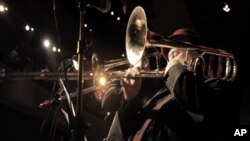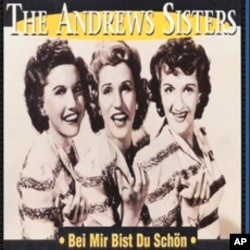Mix the pounding, hip-swaying drums of Afro-Cuban jazz with lilting Jewish tunes from mid-1900s New York, and what do you get? Jewish Latin jazz.
A couple of weeks ago at Yoshi's Jazz Club in San Francisco, the rhythm of the opening song was very Latin-actually, a Cuban-Colombian pachanga. But with a twist.
The language was not Spanish. It was Yiddish. The song was from the New York Jewish theater around 1928.
Odd mixture
How did this odd mixture of Jewish Latin jazz happen? First of all, as New York musician Jeremy Lockwood explains, Jewish music of the early 1900s wasn't just Jewish.
"There's no question in my mind that Yiddish folk songs were very heavily influenced by pop music," he says.
Lockwood, who is dedicated to reclaiming the roots of Jewish music, says it has always reflected the culture in which Jews live.
"That's just what Jewish music is. There's never a period when you have pure Jewish music, except if you go back 2,000 years ago or something."
So the popular Jewish music of the 1930s resembled American pop music of the time. Take the song, "Bei Mir Bist Du Schoen," which means. "To Me, You're Beautiful." Written by Jewish composer Sholom Secunda for the Yiddish theater, it was made famous by the Andrews Sisters, who were Greek Orthodox.
Latin Jewish music
The leap to Latin Jewish music began in Cuba before the 1959 revolution, when the island was a vacation haven for wealthy Americans from the East Coast.
"The Jewish people were really affluent enough to go to Havana on vacation and learn the cha-cha and the mambo," says Latin salsa legend Larry Harlow. Raised a Jew in New York in the early 1940s, Harlow was fascinated by the Latin music he heard streaming out from the city's bars and bodegas. He later traveled to Cuba to learn from the greatest salseros.
Back in the U.S., he, like other Latin musicians, played wherever he could, including at summer resorts in the Catskill Mountains, the warm weather playground of Jews from New York.
"We played rumba, like a Miami Beach rumba, something like that, but didn't play any Jewish music," says Harlow.
Once they'd been introduced to rumbas, mambos and salsa, Jews started buying Latin records. Someone thought an album of Jewish-Latin music would sell, as well. First came the recording "Bagels and Bongos," by Irving Fields. And then, in 1961, "Mazel Tov, Mis Amigos."
'Hodgepodge of influences'
Latin jazz musician Arturo O'Farrill was born in Mexico but raised in New York. He says Jewish Latin music would make no sense if there wasn't a true musical correspondence between the two styles.
"There (are) a lot of similarities in terms of modes and scales and rhythms. The frailach (joyful) rhythm is very closely related to the dotted quarter rhythm that is so prevalent in all of Latino music," says O'Farrill.
Which brings us back to the recent performance at Yoshi's Jazz Club. O'Farrill has been so intrigued by this Jewish Latin fusion that he gathered a band at Yoshi's to reconfigure the songs from the 1961 "Mazel Tov, Mis Amigos."
"What's Jewish culture?" asks O'Farrill. "Jewish culture is a hodgepodge of influences and worlds. What is music? It's the same thing."












